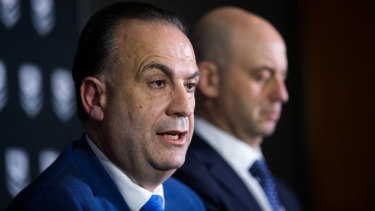SMH Roy Masters 5/12/19
It would seem Australia’s two main football codes are heading in different directions, regarding the length of games and media strategy.
According to a
Herald report,
the ARL Commission will consider dividing NRL games into four quarters, whereas
the AFL is yet to decide if it will cut its half-time break from 20 minutes to 10.
The Peter V'landys Era has begun League Central.Credit:Edwina Pickles
The ARLC’s new chair, Peter V’landys, has silenced his NRL cardinals ahead of Thursday's final commission meeting of the year in order to make an ex-cathedra announcement tomorrow, similar to the wisp of smoke coming from the Vatican chimney, while the AFL ostensibly acts democratically, floating changes to assess public sentiment before reaching a key decision.
Yet there is the same end point for both codes as they seemingly hurtle in opposite directions – their current TV broadcasting deals end in 2022.
The reality is both codes are positioning themselves to demand $2 billion plus for the next rights deals from the same sources – free-to-air TV and Foxtel – and are blowing smoke to achieve it.
AFL fans in Melbourne write letters to the newspapers protesting how shortened half-time breaks mean they will have less time to drink a beer, eat a pie and visit the toilet. But the motive for cutting the main break is not about the fan who attends the game. It’s about the supporter who sits at home watching the game on TV.
Broadcasting revenue is the single biggest source of income to Australian sport.
FTA ratings are in decline worldwide as people watch a myriad of other entertainment on a range of devices. Sport and reality TV are the only guaranteed ratings winners. Channel Nine, the owners of this masthead, had nine of TV’s top 10 programs this year and four were rugby league, allowing Nine to reclaim the crown as No.1 network after 12 years. The AFL grand final on Seven was the only exception.
Games are too long even for older viewers who have acquired the viewing habits of the younger, short-attention-span generations. So, when an AFL game becomes a blowout in the fourth quarter, the less-involved viewers will switch to watch an episode of
The Queen on Netflix? And so, Seven loses the quarter-hour ratings for the rest of the match.
Similarly, V’landys must know it is counter-productive to extend the length of NRL games when his administration is doing all it can to reduce “elapsed time” - speeding up decision-making of the video referee, cutting the time of re-starts of play, minimising penalties...
NRL games are 80 minutes; AFL games are 100 minutes, without the breaks. Why extend the viewing time of NRL when its rival code plans to reduce the length of its game, with ratings figures universally saying the average millennial has the attention span of a gnat?
Inserting more TV advertising into the first- and three-quarter time breaks of NRL games at a time when the AFL is seeking to halve its commercials during the main divide doesn’t add up.
The answer is to unify online streaming. An NRL fan can watch some games on six different platforms ... Channel Nine, Nine Now, Fox Sports, Foxtel Go, Kayo and Telstra (via NRL app).
Whichever broadcaster secures the rights next time will want to monopolise streaming, rather than see advertising leaked to multiple platforms.
A network will pay a premium to be the exclusive digital home of live NRL. Nine has seen strong growth on Nine Now; Kayo is Fox Sports' big bet on the future and Telstra has effectively bundled NRL and AFL content for all mobile phone customers. There is likely to be strong competition from other bidders.
NRL finished 2019 ahead of AFL on FTA and Fox, even before the end-of-season Test matches. According to sportsindustry, an Adelaide-based app that tracks sports viewership, rugby league had 116.23 million viewers on Nine and Fox at an average of 490,000 per match, while AFL was 111.9m on Seven and Fox at an average of 419,000.
Related Article
NRL 2020
NRL could divide matches into quarters to beef up broadcast deal
Fox would not exist without the NRL. When AFL and NRL Fox figures are combined, sportsindustry says Collingwood is the AFL’s top-rating club in rank 13 "with 12 NRL teams above it". It continues: "Every other AFL team has an average lower than the lowest rating NRL team – Gold Coast."
Overall, AFL consumes more hours (277.9m), compared to the NRL (190m), but rugby league is the most valuable sport in Australia....by half.

